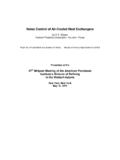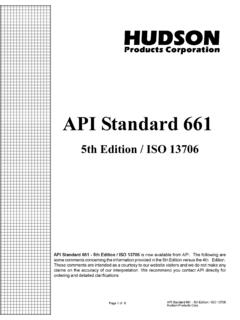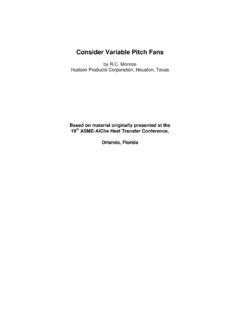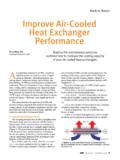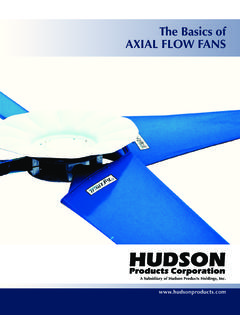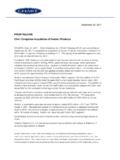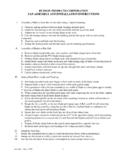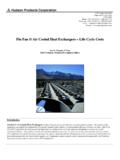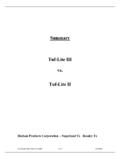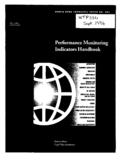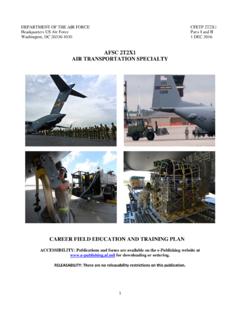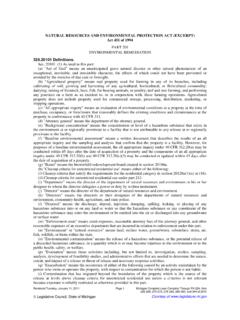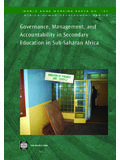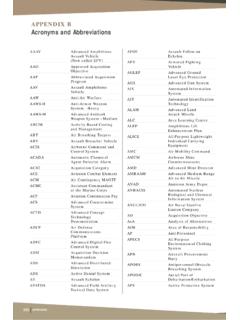Transcription of The Design of Quiet Air-Cooled Heat Exchangers
1 HUDSON PRODUCTS CORPORATION The Design of Quiet Air-Cooled heat Exchangers Page 1 of 20 The Design of QuietAir- cooled heat ExchangersA Paper forThe Energy Resources Conservation BoardNovember 9, 1993 Calgary, AlbertabyAudrey Pinkerton and Sam ChappleEnvironmental Noise ControlHUDSON PRODUCTS CORPORATION The Design of Quiet Air-Cooled heat Exchangers Page 2 of 20 SUMMARYAir- cooled heat Exchangers are a source of plant noise. Therefore, it is important to Design each unit toproduce the minimum amount of noise while still meeting the thermal requirements at a reasonablecost. This paper discusses the major noise sources of an Air-Cooled heat exchanger , the factorsaffecting the noise from each source, and how the source affects the overall noise level of the air-cooledheat industrial facilities are required to meet stringent noise requirements.
2 These requirements areimposed to protect workers hearing and/or to meet community ordinances. The facilitydesigner must pay careful attention to the noise level of all industrial equipment, includingair- cooled heat for community noise requirements are made at the plant boundary or nearest residencein the far field of the heat exchanger . The far field is defined as the region where there is a linearrelationship between the sound pressure level measured and the distance from the noise Figure 1 Near vs. Far FieldFree fieldReverberant fieldNear fieldFar fieldlog rHUDSON PRODUCTS CORPORATION The Design of Quiet Air-Cooled heat Exchangers Page 3 of 20In the far field , the sound pressure level will drop 6 dB with each doubling of distance. The far field willgenerally begin at a distance of twice the largest machine dimension.
3 For instance, if a heat exchangeris 16 x 20 , then the far field will begin at 40 from the source. In the far field , the sound pressure levelcan be calculated bySPL=PWL+10*log10(1/As)+.2(As in m2) As is the surface area over which noise is radiated. See Figure 2 Calculating SPL in the Far FieldNoise will tend to radiate from a non-directional source uniformly in all directions. Sound pressurewaves move spherically away from the source. The radius of this sphere is the distance to the mea-surement point. However, if there is a reflective surface impeding spherical radiation, then the radiationwill become only partially spherical. In this case, the surface area also depends on the height of thenoise source above the ground. In this case,As=2 *r(r+h)If the height goes to 0, the radiation takes on a hemispherical shape andAs=2 *r(r+0)= 2 * H HUDSON PRODUCTS CORPORATION The Design of Quiet Air-Cooled heat Exchangers Page 4 of 20In-plant noise requirements are generally in the near field of the noise source.
4 In this region, soundpressure levels are difficult to predict because of the nonlinear relationship between sound pressurelevel and distance from the source. See Figure , noise sources that are not directional in the far field may be directional in the near field . Figure 3shows typical sound pressure levels at 3 from the edge of an exchanger . Noise levels to the side of theheat exchanger are much lower than levels directly above and below the heat exchanger . The maxi-mum noise level at 3 from the noise source is often specified to insure that workers will not be exposedto unacceptable noise levels. This information must be supplied in addition to Sound Power Level datasince one cannot be inferred from the 3 Sound Pressure Levels in the Near Fieldof an Air-Cooled heat Exchanger84 dBA71 dBA85 dBAHUDSON PRODUCTS CORPORATION The Design of Quiet Air-Cooled heat Exchangers Page 5 of 20 NOISE FROM AN Air-Cooled heat EXCHANGERThe American Petroleum Institute has issued a recommended practice for measuring noise from Air-Cooled heat Exchangers .
5 API RP 631M specifies a hemispherical test method with 13 measurementpoints. Figure 4 shows a test facility set up to perform this test. This facility is equipped with thirteenprecision, permanently mounted microphones and an octave band analyzer with the ability to recordLeq sound levels. This precision instrumentation and hemispherical test method give a repeatability of dBA, Using this test facility and tests on customer units, we have gathered considerable data onair- cooled heat exchanger 4 Noise Test FacilityHUDSON PRODUCTS CORPORATION The Design of Quiet Air-Cooled heat Exchangers Page 6 of 20 Air-Cooled heat Exchangers have four main noise sources: fans, drives, motors, and structural vibra-tion. heat exchanger noise is a function of fan tip speed, input power, diameter, and pitch angle, plusfactors for tip clearance, inlet flow conditions, motor noise and drive noise.
6 A typical 1/3 octave bandheat exchanger noise spectrum is shown in Figure 5 below. Note the absence of pure tones. Becauseheat exchanger noise is made up of noise from several sources, all at different frequencies, the noise isbroad band in NOISEFan noise is the greatest contributor to Air-Cooled heat exchanger noise. The following equationrepresents the noise from a standard heat exchanger fan:PWL=C+30*log10(TipSpeed/1000)+10*log 10(hp)-5*log10(Dia.) + f(pitch angle, tip clearance, inlet flowconditions)Figure 5 Air-Cooled heat exchanger Noise SpectrumHUDSON PRODUCTS CORPORATION The Design of Quiet Air-Cooled heat Exchangers Page 7 of 20 Blade Design is the primary factor affecting fan noise. The blade Design determines the pressurecapability of the blade. Since the pressure is proportional to the fan speed squared, added pressurecapability means a fan can run slower and do the same work.
7 From the equation above, the reductionin noise due to fan speed will be 30*log10(TipSpeed2/TipSpeed1). In addition, there are noise reduc-tions inherent to the blade Design . The following is an example of how different blade designs cangenerate very different noise example compares three types of blades: straight chord, tapered chord and low noise. Typicalstraight chord fan blades are made of extruded aluminum. These blades have the lowest pressurecapability of blades used in Air-Cooled heat tapered chord blades are made of fiberglass reinforced plastic molded with taper and twist inthe airfoil. The tangential velocity of the blade is much greater at the tip than it is at the inboard work an airfoil can do is related to its angle of attack and its tangential velocity in the medium.
8 Tocompensate for the lower tangential velocity, the twist (angle of attack) and chord width are increasedtoward the inboard section of the blade. The purpose of this is to maximize work done at all points alongthe blade. The result is a blade with good pressure capability ( X straight chord blade) and highefficiency which is useful for meeting most noise noise blades are similar to standard tapered blades with a tapered, twisted airfoil, but with a muchwider chord. These blades have twice the pressure capability of standard tapered blades ( x straightchord blades). One of the most effective methods of air cooler noise control is to utilize low noise fanblades that have a very high-pressure capability and move the same air at lower tip speeds, thereforereducing the noise generated by the example shown in Figure 6 is an actual Air-Cooled heat exchanger installation with wg staticpressure and 126,738 cubic feet per minute airflow.
9 A straight chord fan must turn at 9000 FPM tipspeed to do the required work. The Sound Power Level (PWL) from this fan is 96 dBA. A standardtapered fan with taper and twist in the airfoil can turn 8000 FPM to do the required work with a PWL A low noise fan with maximum pressure capability can turn 6600 FPM with a PWL of Thelow noise fan generates dBA less noise than the straight chord 6 Comparison of Noise from Different Blade DesignsCOMPARISON OF FAN NOISE Pressure varies with Fan Speed 2 Fan speed has greatest effect on noiseAluminum Fan(straight chord)Lowest pressure capability9000 FPM96 dBAStandard Hudson Fan(tapered chord)Pressure = x Aluminum Fan8000 dBALow Noise Hudson Fan(maximum pressure capability)Pressure = x Aluminum6600 dBA Noise reduction possible with Hudson Low Noise Fans: dBABased on installation in an air cooler requiring.
10 718 static pressure and 126,738 ft3/min airflowHUDSON PRODUCTS CORPORATION The Design of Quiet Air-Cooled heat Exchangers Page 8 of 20 Inlet flow conditions, tip clearance and recirculation at the fan hub can also affect fan noise. Inlet bellsshould be smooth and rounded, and obstacles in the air stream should be minimized to promote non-turbulent flow into the fan. Tip clearance and recirculation at the fan hub affect efficiency. As inputpower increases due to lost efficiency, noise increases by 10* log10 (HP2/HP1). Seal discs shouldalways be used to prevent losses at the hub. A tip seal may be used if tip clearance is , lost efficiency and blade Design may affect the overall noise level at the Air-Cooled heatexchanger up to 8 NOISED rive noise can contribute 1-3 dBA to the overall noise of the Air-Cooled heat emit noise at the gear mesh frequency, the frequency at which the teeth of the gear sprocketscome together.
